Update 2014 - New Underbody on Page 5
**UPDATE 3/18/12****
See post 36 for Testing updates!
In summary, testing shows the downforce of this underbody system compared to stock are:
70mph- Delta of apx. 302lbs
85mph- Delta of apx. 473lbs
100mph- Delta of apx. 543lbs
140mph- Delta of apx. 746lbs
------------------------------------------------------------------------------------------------------
So my car has been a very reliable and fun daily driver and weekend track car...to the point I would say it one of the best platforms for a DD/Weekend Warrior.
This next year will be much more focused on Track events and less on daily driveability...I'm registered for NASA TT-A (unfortunately the fastest class..Ill likely get less-grippy tires to shed some points) and will be doing quite a bit more competitive events..(Red Line TT, Super Lap Battle, etc)
The car is a 2008 E90 335i...on the street it has 440hp/500tq; however due to heat and snail-sized snails, it is capped to 300/300 for the track. (which also keeps points/class down) Suspension is fully setup with ASTs, good control arms, alignment, etc. The main things that are seperating this car from being a full-on track car is 1) Full-on Role Cage/completely gutting the interior and 2) Complete Aero system.
Since it is still a DD and I don't intend on it being a dedicted track car, I'm not concerned about a roll cage at this point.
So that leaves the Aero system. I’ve done a LOT of extreme-learning over the past month or so and have a complete new understanding of the complexity of aerodynamics when applied to cars; sedans in particular.
In short, the goal with any track car is to:
1) Reduce drag… including making the front as concise and smooth as possible, limiting the amount of air that is allowed under the car, making the body streamlined, and reducing the Flow Separation/rear vacuum created by the car’s wake.
2) Increase Downforce…this is the fun part. Most of the downforce will be created by low pressure underneath side of the car; with the fine tuning of wings, Canards and air dams.
The underbody should be made up of 4 Pieces: Splitter, Undertray, Side Skirts and Rear Diffuser. The most important thing to keep in mind with all of this; is that everything works as a system. None of these pieces alone will achieve high results unless they are all in place and functioning properly.
Splitter- There are 2 benefits of the front splitter.
1) To split air. Duh. This is the lowest, level piece of the front of the car; the choke point for the air to get underneath. This reduction of air is noticed throughout the entire underbody. Not only does it simply reduce it…but because of the smooth undertray it is accelerated. According to Bernoulli’s Principle, Accelerated air = lower pressure. Lower Pressure beneath = downforce. The lower it goes; the better the car blows
2) To provide real-estate for the high-pressure air that is created by the front bumper pushing through the air. The airdam (piece right above the splitter) essentially blocks the air; and the high pressure pushes down on the splitter.
 splitter3
splitter3 by
MDM Enterprises, on Flickr
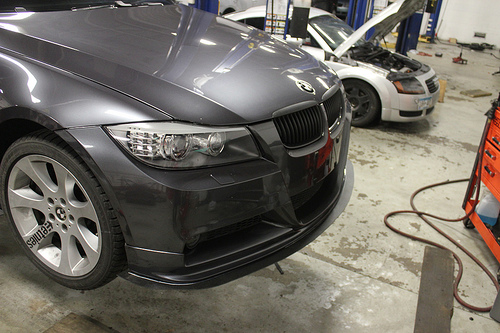 splitter2
splitter2 by
MDM Enterprises, on Flickr
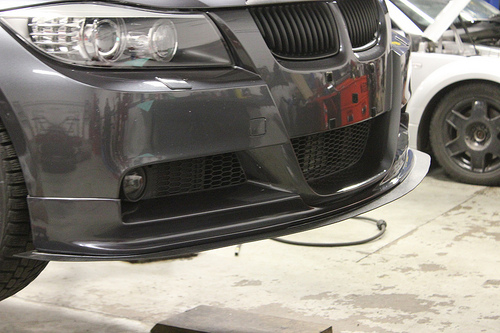 splitter1
splitter1 by
MDM Enterprises, on Flickr
Underbody Smoovness- This is pretty self- explanatory. Many cars today come with semi-smooth belly pans; but anything rear of the transmission is bare and bumpy. Any open areas, exhaust channels, subframes/control arms, etc. create turbulence. This turbulence slows down the air, creates drag and minimizes the effect of the system.
**It is important to note that the underside of the car does serve another purpose: To extract heat from the engine bay. There is very high pressure in the engine bay from the incoming air; and it can only go through the gap between the hood and windshield (also high pressure), or flow backwards around the transmission and out an opening in the underbody. Because of this I’ve left open the area behind the transmission and front of the exhaust tunnel. The extra low pressure of this whole system should also help extract more heat.
 underbody3
underbody3 by
MDM Enterprises, on Flickr
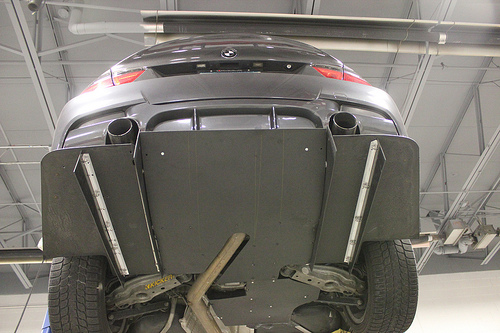 underbody2
underbody2 by
MDM Enterprises, on Flickr
Diffuser- This puts the “rice” in “Hey, look at that ricer”. Whilst it may end up looking like KTran’s NSX, the gains to be had from it are incredible. The basic goals of a diffuser are to utilize the expanding area to slow down the air whilst not increasing pressure, so that when the faster air under the car meets the slower air on top of the car, less Flow Seperation (Vacuum bubble) occurs…which reduces drag.
The angle of attack for the diffuser should be adjustable from 6-15*; with 9.5* being seen as “ideal”. Thankfully my design just happened to be adjustable in that exact range

The design of my diffuser was VERY much controlled by the exhaust muffler and tips hanging down. For practicality’s sake, It would have been ideal to have the rear diffuser flat across,and span the width of the inside of the entire car, and be fenced off inside of the rear wheels. If it weren’t for the large muffler; I’d be able to use a better starting height and slow down the air even more. So this forced me to do a 3-piece design, which has two static sides (behind the rear wheels) and one center section under the muffler which is adjustable.
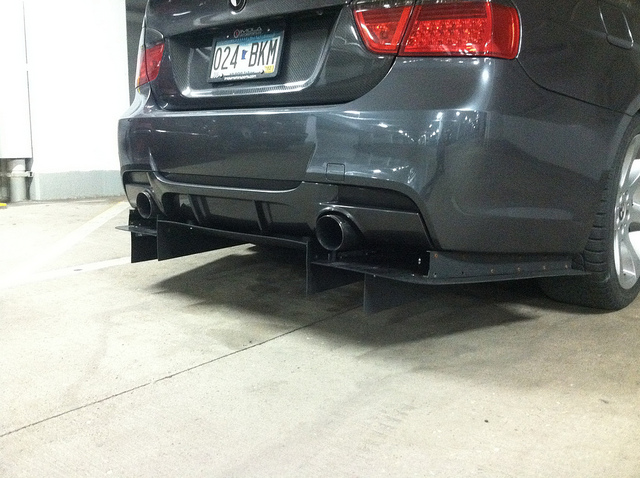 diffuser4
diffuser4 by
MDM Enterprises, on Flickr
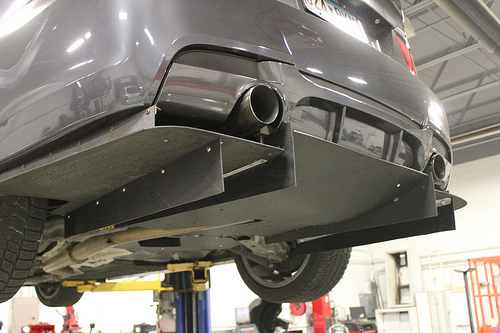 diffuser3
diffuser3 by
MDM Enterprises, on Flickr
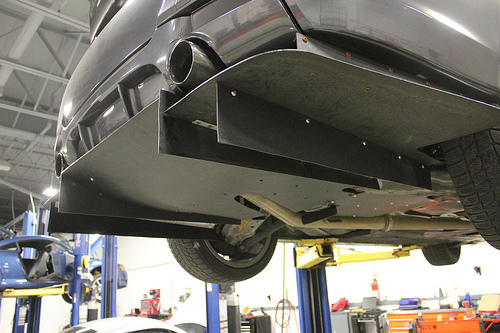 diffuser2
diffuser2 by
MDM Enterprises, on Flickr
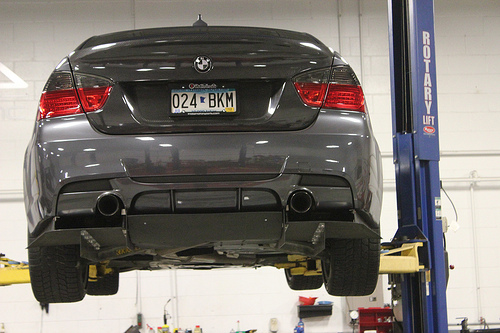 diffuser1
diffuser1 by
MDM Enterprises, on Flickr
Side Skirts/Fences. Now if the splitter, diffuser and complete underbody were setup, then that would create very low pressure underneath the car. …however that low pressure would instantly be balanced by the atmospheric pressure outside of the underbody… eliminating any real benefit of this aero system. Because of this, it is important to “fence” off the underbody so that the low pressure stays inside where it belongs.
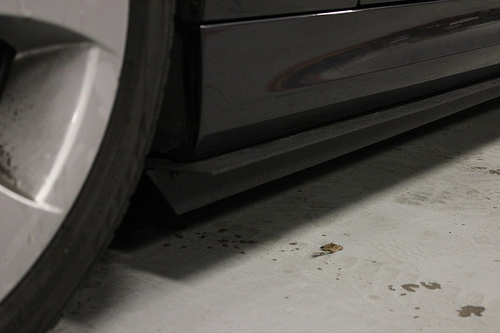 Side skirts1
Side skirts1 by
MDM Enterprises, on Flickr
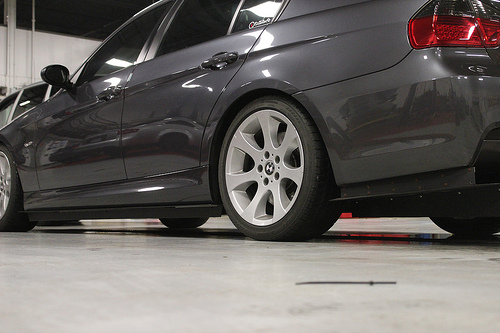 side skirts4
side skirts4 by
MDM Enterprises, on Flickr
 side skirts2
side skirts2 by
MDM Enterprises, on Flickr
 side skirts3
side skirts3 by
MDM Enterprises, on Flickr
To test this I’ve bought a Digital Manometer; which can measure very small pressure differentials between two areas. Extrapolating data into the entire system will be difficult; but I simply want to see a significant pressure decrease and also use it to troubleshoot other problem areas.
All in all; I am hoping this aero system will convert the ~150lbs lift into 500lbs of downforce at 100mph. I will definitely update this as I collect data and have some experiences on the track!
Thanks for reading,
Brian